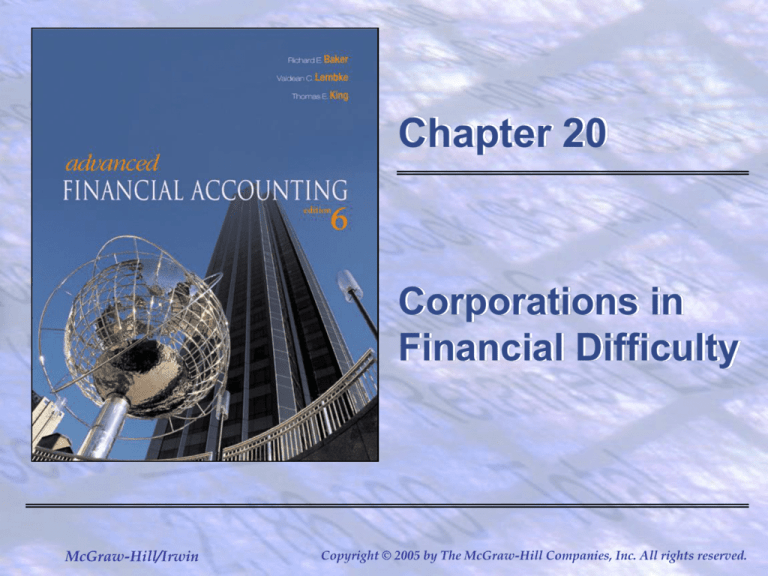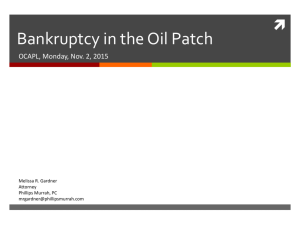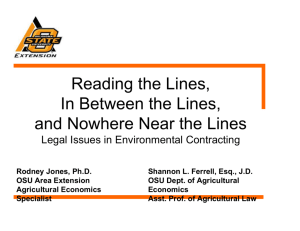
Chapter 20
Corporations in
Financial Difficulty
McGraw-Hill/Irwin
Copyright © 2005 by The McGraw-Hill Companies, Inc. All rights reserved.
Companies in Financial Difficulty
• A company in financial difficulty has a large
number of alternatives, of which bankruptcy
is only a final course.
• This chapter presents the range of major
actions typically used by a company
experiencing financial problems.
20-2
Reasons for Financial Difficulty
• Companies get into financial difficulty for a large
variety of reasons:
–
–
–
–
–
Continued losses from operations
Overextended credit to customers
Poor management of working capital
Inadequate financing
Failure to react to changes in economic conditions
20-3
Liquidity Problems—A Vicious Cycle
• Failing to make a sufficient level of sales, a
company cannot obtain adequate financing, then
begins to miss debt payments, and the vicious
cycle of financial difficulty is under way.
• At this point, outside creditors may decide to
exercise their claims and demand payment of
their receivables.
20-4
Alternative Courses of Action
• The debtor company has a number of
alternative courses open to it:
– Reach an agreement with its creditors to
postpone required payments.
– Turn its assets over to its creditors to liquidate.
– Take the legal remedy of bankruptcy.
20-5
Other Reasons for Bankruptcy
• A company may petition the courts for
bankruptcy for other reasons, such as to
protect itself from an onslaught of legal suits.
• Several companies have also attempted to void
union contracts by petitioning for bankruptcy.
• The courts are still defining the exact limits of
bankruptcy, and each case must be decided
individually.
20-6
Courses of Action
• Nonjudicial Actions: Formal agreements
between the company and its creditors are
legally binding, but are not administered by
a court. Examples: Debt Restructuring and
Voluntary Asset Assignment.
• Judicial Actions: Bankruptcy is a judicial
action administered by bankruptcy courts
and bankruptcy judges provided in the
Bankruptcy Reform Act of 1978 (hereafter,
Bankruptcy Reform Act).
20-7
The Bankruptcy Reform Act
• The Bankruptcy Reform Act provides for
two major alternatives under the protection
of the bankruptcy court.
• These two alternatives are often known by
the chapters of the Bankruptcy Reform Act:
– Chapter 11 Reorganization
– Chapter 7 Liquidation.
20-8
Chapter 11 Reorganization
• Under a Chapter 11 reorganization, the debtor
is provided judicial protection for a rehabilitation
period during which it can eliminate unprofitable
operations, obtain new credit, develop a new
company structure with sustainable operations,
and work out agreements with its creditors.
20-9
Chapter 7 Liquidation
• A Chapter 7 liquidation is often administered
by a trustee appointed by the court.
• Under a Chapter 7 liquidation, the debtor’s
assets are sold and its liabilities extinguished
as the business is liquidated.
20-10
Reorganization versus Liquidation
• The major difference between a reorganization
and a liquidation is that the debtor continues as
a business after a reorganization, whereas the
business does not survive a liquidation.
20-11
Creditor Accounting for Impaired Loans
• FASB 114 presents the creditor’s accounting
and disclosure standards for impaired loans,
including notes receivable.
• A loan is defined as being impaired when it is
probable that the creditor will not be able to
collect all amounts due under the loan
agreement.
20-12
Measurement of Impaired Loans
• If the loan is collateral-dependent, that is, the
creditor determines that foreclosure is probable,
the loan value should be measured by using the
fair value of the collateral.
• Otherwise, impaired loans are measured based
on the present value of expected future cash
flows, discounted at the loan’s effective interest
rate at the point of origination of the loan.
20-13
Troubled Debt Restructuring
• The most common form of troubled debt
restructuring is a modification of the debt terms
to alleviate the short-term cash needs of the
debtor.
• For example, the creditor may reduce the
current interest rate, forgive some of the accrued
interest or principal, or modify some other term
of the debt agreement.
20-14
Troubled Debt Restructuring
• Another common form of troubled debt
restructuring is the creditor’s acceptance
of assets or equity with a fair value less
than the amount of the debt.
• For example, the creditor may accept land
with a fair value of $50,000 in exchange for
extinguishing a debt of $65,000, because
the creditor feels the $50,000 is the
maximum amount it will be able to collect.
20-15
Restructuring Difference (Debtor)
• In order to calculate the restructuring difference
(i.e., gain or loss on restructuring), the debtor
compares the carrying value of the debt with the
total future cash flows related to the debt, or with
the fair value of the consideration exchanged in
extinguishment of that debt (see FASB 15).
20-16
Restructuring Difference (Creditor)
• Under FASB 114, the creditor accounts for a
troubled debt restructuring as an impairment
of a loan.
• In order to calculate the restructuring difference
(i.e., gain or loss on restructuring), the creditor
compares the carrying value of the debt with the
present value of the estimated total future cash
flows, or with the fair value of the consideration
exchanged in extinguishment of that debt.
20-17
Restructuring Gains
• The gain on the restructuring of debt is reported
on the debtor’s income statement according to
the criteria in APB 30. Stated otherwise, if the
gain is material, is of an unusual nature, and has
an infrequency of occurrence, then it is reported
as an extraordinary item.
20-18
Restructuring Gains
• Note that FASB 145 rescinded FASB 4.
• FASB 4 had required extinguishment of
debt gains to generally be reported as
extraordinary items.
• Thus, these gains are now typically
reported as part of continuing operations.
20-19
Restructuring Gains
• Not all negotiations of debt covenants are
troubled debt restructurings; the restructuring
must be a concession granted to a debtor in
financial difficulties.
• Renegotiations between a debtor and a creditor
because of changes in the competitive general
economic environment are not troubled debt
restructurings and are not included in FASB 15
and FASB 114.
20-20
Contingent Payments
• Some restructuring agreements contain
provisions for contingent payments. For
example, the agreement may specify that
the debtor must pay an additional amount if
its future net income exceeds a certain level.
• At the time of the restructuring agreement,
contingent amounts should be included in
the estimated total future cash payments by
both the debtor and creditor if the conditions
in FASB 5 have been met.
20-21
Chapter 11 Reorganization
• Chapter 11 of the of the Bankruptcy Reform
Act allows for legal protection from creditors’
actions during a time needed to reorganize
the debtor company and return its operations
to a profitable level.
• Reorganizations are administered by the
bankruptcy court, and trustees are often
appointed by the court to direct the
reorganization.
20-22
Chapter 11 Reorganization
• A company in financial distress petitions the
bankruptcy court for protection form its creditors.
• If granted protection, the company receives an
order of relief to suspend making any payments
on its prepetition debt.
• The company continues to operate while it
prepares a plan of reorganization, which serves
as an operating guide during the reorganization.
• The proceeding includes the actions that take
place from the time the petition is filed until the
company completes the reorganization.
20-23
Chapter 11 Reorganization
• SOP 90-7 provides guidance for financial
reporting for companies in reorganization.
• The financial statements issued by a company
during Chapter 11 proceedings should
distinguish transactions and events directly
associated with the organization with those
associated with ongoing operations.
• SOP 90-7 requires that financial statements
clearly reflect the unique circumstances
related to the organization.
20-24
Fresh Start Accounting
• A set of final financial statements is prepared
just prior to emerging from reorganization.
• Thereafter, the company may use “Fresh Start
Accounting” if both of the following conditions
occur (see next slide).
20-25
Fresh Start Accounting (Ch. 11 Reorg.)
• The reorganization value of the assets of the
emerging entity immediately before the date of
confirmation is less than the total of all
postpetition liabilities and allowed claims.
• Holders of existing voting shares immediately
before confirmation receive less than 50 percent
of the voting shares of the emerging entity. This
implies that the prior shareholders have lost
control of the emerging company.
20-26
Plan of Reorganization
• Most reorganization plans include detailed
discussions of the following:
– Disposing of unprofitable operations.
– Restructuring of debt with specific creditors.
– Revaluation of assets and liabilities.
– Reductions or eliminations of claims of
original stockholders and issuances of new
shares to creditors or others.
20-27
Unsuccessful Reorganizations
• The major reason for unsuccessful
reorganizations is continuing losses from
operations and no reasonable likelihood of
rehabilitation.
• Another common reason is the inability to
consummate a reorganization plan because
of the failure to dispose of an unprofitable
subsidiary (etc.). The debtor company then
moves from reorganization into liquidation.
20-28
Chapter 7 Liquidations
• Liquidations are administered by the bankruptcy
courts.
• The intent in liquidation is to maximize the net
dollar amount recovered from disposal of the
debtor’s assets.
• Bankruptcy courts appoint accountants,
attorneys, or experienced business managers as
trustees to administer the liquidation.
• The liquidation process is often completed within
6 to 12 months, during which the trustees must
make periodic reports to the bankruptcy court.
20-29
Classes of Creditors
• A very important aspect of liquidation is
determining the legal rights of each creditor
and establishing priorities for those rights.
• The Bankruptcy Reform Act specifies three
classes of creditors, whose claims have the
following priorities: (1) secured creditors, (2)
creditors with priority, and (3) unsecured
creditors.
• The priority of claims determines the order
and source of payment to each creditor.
20-30
Secured Creditors
• Secured creditors have liens, or security
interests, on specific assets, often called
“collateral.”
• A creditor with such a legal interest in a
specific asset has the highest priority claim
on that asset. For example, a mortgage
payable is secured by the company’s land
and plant.
20-31
Creditors with Priority
• Creditors with a priority are unsecured creditors,
that is, those having no collateral claim against
specific assets, who have priority over other
unsecured creditors.
• Creditors with priority are the first to be paid from
any proceeds available to unsecured creditors.
• Any remaining monies are then distributed to the
general unsecured creditors.
20-32
Summary--Creditors with Priority
• Costs of administering the bankruptcy, including
accounting and legal costs for experts appointed
by the bankruptcy court.
• Liabilities arising in the ordinary course of
business during the bankruptcy proceedings.
• Certain wages, salaries, or commissions.
• Certain contributions to employee benefit plans.
• Certain deposits of customers.
• Unsecured tax claims of government units.
20-33
General Unsecured Creditors
• The lowest priority is given to claims by general
unsecured creditors.
• These creditors are paid only after secured
creditors and unsecured creditors with priority
are satisfied to the extent of any legal limits.
• Often, the general unsecured creditors receive
less than the full amount of their claim.
20-34
Statement of Affairs
• The accounting statement of affairs is the basic
accounting report made at the beginning of the
liquidation process to present the expected
realizable amounts from disposal of the assets,
the order of creditors’ claims, and the expected
amount unsecured creditors will receive as a
result of the liquidation.
20-35
Statement of Affairs
• The statement of affairs presents the balance
sheet accounts in order of priority for liquidation.
• The statement of affairs presents estimated
current fair values and expected gains or losses
on the disposal of the assets.
20-36
Trustee Accounting and Reporting
• Bankruptcy courts appoint trustees to manage a
company under Chapter 11 reorganizations in
cases of management fraud, dishonesty,
incompetence, or gross mismanagement. the
trustee then attempts to rehabilitate the
business.
20-37
Trustee Accounting and Reporting
• In Chapter 7 liquidations, the trustee normally
has the responsibility to expeditiously liquidate
the bankrupt company and pay creditors in
conformity with the legal status of their secured
or unsecured interests.
20-38
Receivership
• Sometimes the trustee receives title to all assets
as a receivership, becomes responsible for the
actual management of the debtor, and must
direct a plan of reorganization or liquidation.
• A trustee who takes title to the debtor’s assets in
a liquidation must make periodic financial report
to the bankruptcy court, reporting on the
progress of the liquidation and on the fiduciary
relationship held.
20-39
Statement of Realization and Liquidation
• A monthly report, called a statement of
realization and liquidation, is prepared for the
bankruptcy court. It shows the results of the
trustee’s fiduciary actions beginning at the point
the trustee accepts the debtor’s assets.
• The statement has three major sections:
• Assets
• Supplementary items
• liabilities
20-40
Statement of Realization and Liquidation
• The statement presents the assets transferred to
the trustee, the additional assets acquired by the
trustee, and the ending balance of unrealized
assets still to be converted into cash.
• The statement also reports on the debtor’s
liabilities discharged by the trustee as well as the
additional liabilities incurred by the trustee.
• Supplementary charges include the trustee’s
administration fees and any cash expenses paid
by the trustee. Supplementary credits may
include any unusual revenue items.
20-41
Bankruptcy Provisions for Individuals
• In addition to Chapter 7 bankruptcies, individuals
have the opportunity to use the provisions of
Chapter 13 of the Bankruptcy Reform Act,
entitled “Adjustment of Debts of an Individual
with Regular Income.”
• An individual may file for bankruptcy only once
every seven years.
20-42
You Will Survive This Chapter !!!
• The major difference between a reorganization
(Chapter 11) and a liquidation (Chapter 7) is
that the debtor continues as a business after a
reorganization, whereas the business does not
survive a liquidation.
• AVOID PERSONAL BANKRUPTCY !!!
(Chapter 13 of the Bankruptcy Reform Act)
20-43
Chapter 20
End of Chapter
McGraw-Hill/Irwin
Copyright © 2005 by The McGraw-Hill Companies, Inc. All rights reserved.





